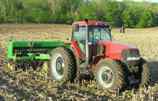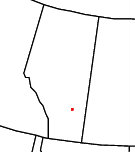|
|

central - east central Minnesota - | Has this question been brought up before ?
Where did the term "Frog" come from - frog that holds cutting edges . .. the railroad industry has the term also - frog holds or encase rails (if I recall). What's the history with that term (frog) ? TIA |
|
| |
|
Home Columbia Mo. Row Crop Farm Novinger Mo. | I have had the same thought. |
|
| |
|
Leeds, North Dakota | Chris seems to me something with a plow, was a young pup, lets see what Nat brings up, Scott. |
|
| |
|
s nd | It was easier to spell than giraffe? |
|
| |
|
North Central Kansas | ribbit ribbit |
|
| |
|
Leeds, North Dakota | http://www.lowerymanufacturing.com/images/Moldboard%20Plow.pdf Scott. |
|
| |
|
central Indiana | one definition is a triangular mass used for support. that is how it is used on a moldboard plow. support on the backside for points and moldboard |
|
| |
|
West Salem, Illinois | but the term frog when it applies to the railroad is the rail opposite the switch point. It is a large triangular shaped piece that goes off to the two seperate rails. If you kind of stand over it correctley and look down track it does look something similar to a frog, the legs are the two rails and the triangular part is the body. I would take a picture if my tracks weren't under all of this snow! |
|
| |
|
Sanilac Co. Michigan | I don't know.......could be the first thing that "leaped" to mind! Horrible pun, I know. |
|
| |
|
| The frog is a part of a horse's hoof, located on the underside, which should touch the ground if the horse is standing on soft footing. The frog is triangular in shape, and extends from the heels to mid-way toward the toe, covering around 25% of the bottom of the hoof.[1] The frog acts as a shock absorber for the foot when it makes impact with the ground, decreasing the force placed on the bones and joints of the leg.
The frog is not only a shock absorber, it is also an important part of the horse's circulatory system — it pumps blood up the horse's leg each time the frog makes contact with the ground. The blood flows down the horse's leg into the digital cushion, a fibrous part of the inner hoof located just above the frog which contains a network of blood vessels. The horse's weight then compresses the frog on the ground, squeezing the blood out of the digital cushion, and pushing it back up the horse's legs.
|
|
| |
|
Sac & Story county IA | Way over thinking this. Something that looks like a triangle. |
|
| |
|
Soutwest Ks. | But I didn't know that a sweep plow frog had circulation!!! |
|
| |
|
central Indiana | that makes perfect senese Ifarm as that term would of naturally been transferred to a moldboard plow |
|
| |
|
| Dictionary entries provide some clues: http://www.merriam-webster.com/dictionary/frog My guess would be things that are triangular in shape, and/or a piece that clasps another (like frog legs & toes wrap around things to hold on). |
|
| |
|
| The triangular part that holds the blade on a wood plane is also a frog. |
|
| |
|
New Brunswick, Canada | I've heard older folks call the triangle web of skin in between index and thumb the frog of their hand, not sure if that is related. |
|
| |
|
Near-north Ontario, French River | Probably over thinking it again but why call something that's shaped like a triangle a frog?? We all know what plow frog is,but the shape itself doesn't lend itself to the name 'frog', why not call it a triangle??? |
|
| |
|

Alberta, Canada | Ifarm has it right. There is a reason we measure tractors by horsepower. Harnessing horses was huge in human progress. And the frog in their foot is huge to a horse's soundness. Hence the tendency to label similar shaped objects frogs. That said, in Canada there can be a second meaning. |
|
| |
|
Snipesville, GA | There are also frogs on peanut inverters or diggers that hold the digging blade. |
|
| |
|

White Stone, Virginia | Also the triangular shaped piece that used to hold the bayonet scabbard to a soldier's belt used to be called a frog. |
|
| |


 FROG - Why's it refered to as a FROG ?
FROG - Why's it refered to as a FROG ?